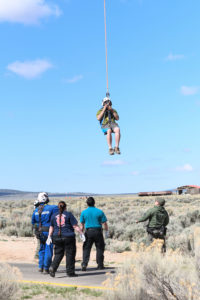
A Bernalillo County Sheriff’s Department Airbus AS350 B3 quickly executed short haul operations to rescue a man from the bottom of Rio Grande Gorge in Taos, New Mexico, on May 5.
The man had made his way to the bottom of the gorge — which has a depth of 800 feet (244 meters) — on May 4, and had sustained a leg injury. Personnel from a New Mexico search-and-rescue team made contact with the man, who was slightly hypothermic, and were able to provide overnight care to him at the bottom of the gorge. Due to a past traumatic brain injury, the man’s ability to communicate how he got to the bottom of the gorge was “somewhat altered,” according to Lt David Lujan, public information officer with Bernalillo County Fire Department.
Advertisement
In the early morning hours of May 5, the decision was made to request air support. The state of New Mexico has limited gatherings to no more than five people amid the current Covid-19 crisis, and Lujan said a ground rescue operation would have required roughly 15 to 20 personnel to safely get the man out of the gorge.
Bernalillo County Sheriff created a dispatch at 6:30 a.m., and “we started getting our personnel up to our hangar where our [Metro] Air Support Unit is at,” said Lujan. The AS350 departed Double Eagle II Airport in Albuquerque at 8:10 a.m. with a single pilot and paramedic on board and flew for roughly an hour and 20 minutes to get to the scene in Taos.
“We arrived on time, did a quick flyover and then basically reconfigured the aircraft,” said Larry Koren, an undersheriff and pilot with Bernalillo County Sheriff’s Department, who also flew the rescue mission in Taos.

The paramedic was lowered to the bottom of the gorge on a 150-foot short haul line to reach the patient, then removed himself from the line, and put the extrication device on the patient. “To make sure that we were in the proper power parameters, the patient was lifted out by himself on the short haul line,” said Lujan.
It was a quick five-minute flight to a nearby parking lot where paramedics and search-and-rescue crews were ready to receive the patient to provide further care.
Koren said it was a 30-minute process from the time the aircraft arrived on scene and was reconfigured, to the helicopter arriving back to the gorge to pick up the paramedic after the patient was delivered.

The sheriff’s department operates a Bell UH-1 Huey in addition to the AStar, and flies multiple types of missions including airborne law enforcement, search-and-rescue and fire bucket operations. Because the AS350 is a multi-mission aircraft for the sheriff’s department, the crew are well-trained in reconfiguring the helicopter.
“Every one of our personnel are trained and regularly practice reconfiguring the aircraft,” said Koren. “That’s something that we do as part of the training qualifications — [this includes] taking off doors, working out weight-balance sheets, and also being able to set up the short haul system in a moment’s notice.”
Advertisement
The Metro Air Support Unit is a collaborative partnership with the Bernalillo County Sheriff’s Department and the Bernalillo County Fire Department, which began roughly six-and-a-half years ago. The helicopter belongs to the sheriff’s department, the pilots and tactical flight officers are sworn deputies, and the paramedics/rescue personnel are part of the fire department. The University of New Mexico (UNM) Reach & Treat program has also partnered with the two agencies on the air unit program, providing paramedics and physicians.

“The sheriff, Manuel Gonzales III, has been a huge advocate for this air unit program and was really pivotal, along with the fire chief, to see this collaboration happen,” said Lujan.
“We’ve conducted multiple air rescues throughout the state of New Mexico, within Bernalillo County, and this wouldn’t have been possible without the collaboration of the sheriff’s department and the fire department — and now, the University of New Mexico’s School of Medicine’s Reach & Treat program.”



